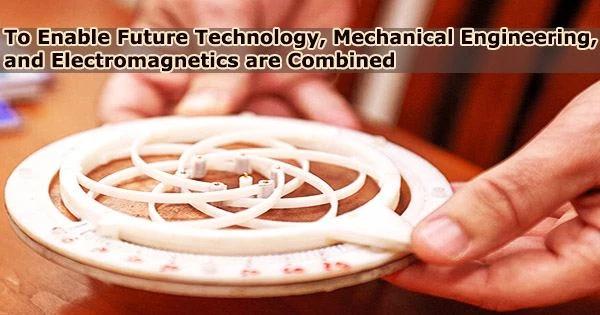Future communication network technologies, like 6G, will depend heavily on reconfigurable antennas that can remotely adjust characteristics like frequency or radiation beams in real-time.
However many of the present reconfigurable antenna designs can fall short because they malfunction in extreme heat or cold, have power restrictions, or need frequent maintenance.
Electrical engineers at Penn State College of Engineering combined electromagnets with a compliant mechanism the same idea used in mechanical engineering to create a bow and arrow to overcome these constraints. They published their proof-of-concept reconfigurable compliant mechanism-enabled patch antenna today (Feb. 13) in Nature Communications.
“Compliant mechanisms are engineering designs that incorporate elements of the materials themselves to create motion when force is applied, instead of traditional rigid body mechanisms that require hinges for motion,” said corresponding author Galestan Mackertich-Sengerdy, who is both a doctoral student and a full-time researcher in the college’s School of Electrical Engineering and Computer Science (EECS). “Compliant mechanism-enabled objects are engineered to bend repeatedly in a certain direction and to withstand harsh environments.”
The complaint mechanism-enabled arms of a reconfigurable antenna bend in a predictable manner when used, changing the working frequencies without the need for hinges or bearings.
“Just like a chameleon triggers the tiny bumps on its skin to move, which changes its color, a reconfigurable antenna can change its frequency from low to high and back, just by configuring its mechanical properties, enabled by the compliant mechanism,” said a co-author Sawyer Campbell, associate research professor in EECS.
Compliant mechanisms are engineering designs that incorporate elements of the materials themselves to create motion when force is applied, instead of traditional rigid body mechanisms that require hinges for motion.
Galestan Mackertich-Sengerdy
Existing origami design methods, so termed after the Japanese art of paper folding, are surpassed by compliant mechanism-enabled designs in terms of resilience, long-term reliability, and high-power handling capabilities.
“Origami antenna designs are known for their compact folding and storage capabilities that can then be deployed later on in the application,” Mackertich-Sengerdy said. “But once these origami folded structures are deployed, they usually need a complex stiffening structure, so that they don’t warp or bend. If not carefully designed, these types of devices would suffer environmental and operational lifetime limitations in the field.”
Using industry-standard electromagnetic simulation tools, the team visualized and created a prototype of a circular, iris-shaped patch antenna. Then, in the anechoic laboratory at Penn State, a room lined with electromagnetic wave-absorbing material that prevents signals from interfering with antenna testing, they used a 3D printer to create it and tested it for fatigue failures as well as frequency and radiation pattern fidelity.
The technology can be scaled to the integrated circuit level for higher frequencies or increased in size for lower frequency applications, according to researchers, even if the prototype created to target a specific frequency for demonstration is just slightly larger than a human palm.
According to the researchers, the rise of 3D printing, which permits limitless design variants, has raised interest in compliant mechanism research. It was Mackertich-Sengerdy’s background in mechanical engineering that gave him the idea to apply this specific class of compliant mechanisms to electromagnetics.
“The paper introduces compliant mechanisms as a new design paradigm for the entire electromagnetics community, and we anticipate it growing,” said co-author Douglas Werner, John L. and Genevieve H. McCain Chair Professor of EECS. “It could be the branching-off point for an entirely new field of designs with exciting applications we haven’t dreamed of yet.”





